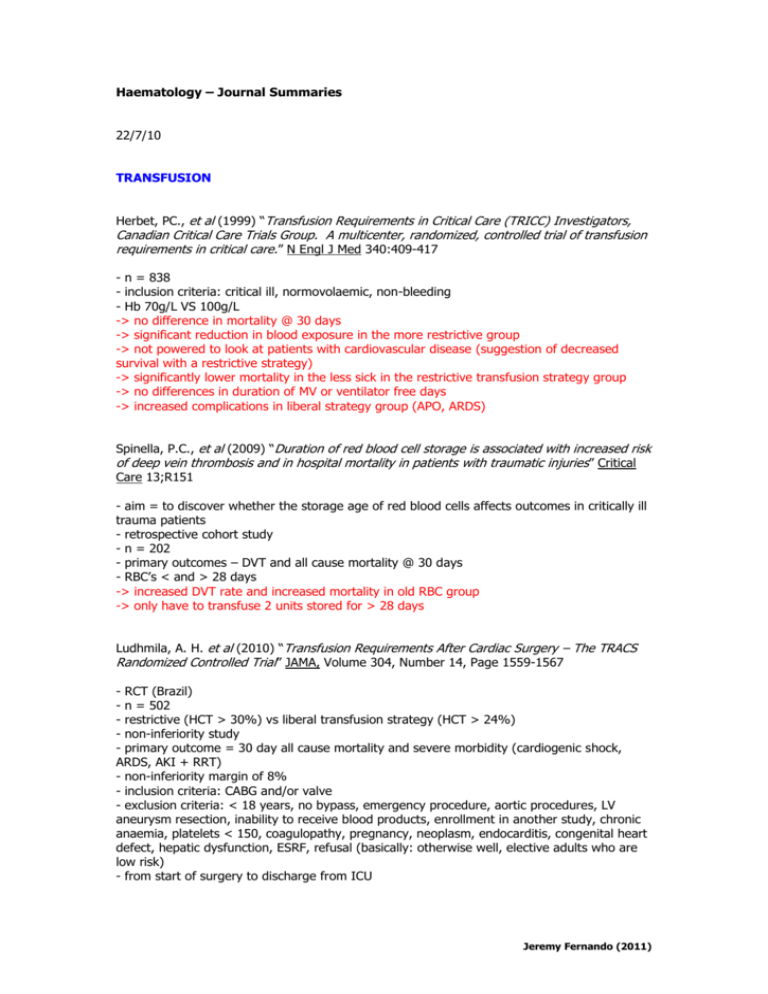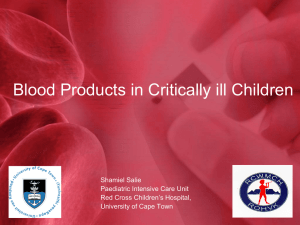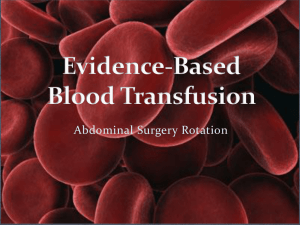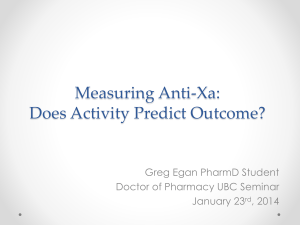Haematology – Journal Summaries - Wellington Intensive Care Unit
advertisement

Haematology – Journal Summaries 22/7/10 TRANSFUSION Herbet, PC., et al (1999) “Transfusion Requirements in Critical Care (TRICC) Investigators, Canadian Critical Care Trials Group. A multicenter, randomized, controlled trial of transfusion requirements in critical care.” N Engl J Med 340:409-417 - n = 838 - inclusion criteria: critical ill, normovolaemic, non-bleeding - Hb 70g/L VS 100g/L -> no difference in mortality @ 30 days -> significant reduction in blood exposure in the more restrictive group -> not powered to look at patients with cardiovascular disease (suggestion of decreased survival with a restrictive strategy) -> significantly lower mortality in the less sick in the restrictive transfusion strategy group -> no differences in duration of MV or ventilator free days -> increased complications in liberal strategy group (APO, ARDS) Spinella, P.C., et al (2009) “Duration of red blood cell storage is associated with increased risk of deep vein thrombosis and in hospital mortality in patients with traumatic injuries” Critical Care 13;R151 - aim = to discover whether the storage age of red blood cells affects outcomes in critically ill trauma patients - retrospective cohort study - n = 202 - primary outcomes – DVT and all cause mortality @ 30 days - RBC’s < and > 28 days -> increased DVT rate and increased mortality in old RBC group -> only have to transfuse 2 units stored for > 28 days Ludhmila, A. H. et al (2010) “Transfusion Requirements After Cardiac Surgery – The TRACS Randomized Controlled Trial” JAMA, Volume 304, Number 14, Page 1559-1567 - RCT (Brazil) - n = 502 - restrictive (HCT > 30%) vs liberal transfusion strategy (HCT > 24%) - non-inferiority study - primary outcome = 30 day all cause mortality and severe morbidity (cardiogenic shock, ARDS, AKI + RRT) - non-inferiority margin of 8% - inclusion criteria: CABG and/or valve - exclusion criteria: < 18 years, no bypass, emergency procedure, aortic procedures, LV aneurysm resection, inability to receive blood products, enrollment in another study, chronic anaemia, platelets < 150, coagulopathy, pregnancy, neoplasm, endocarditis, congenital heart defect, hepatic dysfunction, ESRF, refusal (basically: otherwise well, elective adults who are low risk) - from start of surgery to discharge from ICU Jeremy Fernando (2011) - weird stuff: -> EF and renal impairment not used in exclusion criteria -> blood bank gave those under going cardiac surgery young blood (do we do that?) -> etomidate for induction -> high O2 post (0.6 to 1.0 to keep SpO2 > 95%) -> no milrinone used -> given methylprednisolone 10mg/kg at induction (why?) -> aminocaproic acid rather than TXA2 -> no cell salvage -> intraoperative coagulopathy treated in our manner -> mannitol on pump -> anterograde plegia -> albumin and starch used intraoperatively -> respiratory complications defined as MV > 48 hours (this is pretty generous) -> assumed a 10% incidence in primary outcome (this is pretty generous -> the risk of death or severe morbidity is a lot less than 10% in low risk cardiac patients). -> no difference in FFP, platelets and cryoprecipitate use -> restrictive group: although transfused to a HCT > 24% -> Hb in this group was not less than 90! -> no leukodepletion -> Hb 105 (liberal group) and 91 (restrictive group) – significant difference -> they had a 10 and 11% primary event rate! Man that is high. -> no difference in primary end-point between groups -> number of transfused RBC’s was an independent risk factor for clinical complications or death @ 30 days (with a hazard ratio 1.2) RECOMBINANT FVIIa Mayer, S.A., et al (2005) “Recombinant Activated factor VII Intracerebral Haemorrhage Trial Investigators. Recombinant activated factor VII for acute intracerebral haemorrhage ” N Engl J Med 352:777-785 - Multicentre RCT - n = 399 with acute intracerebral haemorrhage - single IV injection of recombinant factor VIIa (40, 80 or 160mcg/kg) VS placebo within 1 hour of their base line CT head scan. - significant reduction in volume of haematoma on CT @ 24 hours with therapy proportional to dose. - significant reduction in 30 day mortality without increase in severely disabled patients. - no statistically significant increase in thromboembolic events although there was a trend. Levi, M. et al (20100 “Safety of Recombinant Activated Factor VII in Randomized Clinical Trials” NEJM 363:79, pages 1791-800 - goal = evaluate the rate of thromboembolic risk in all published RCT’s using rFVIIA - trials = 35 - n = 4468 Strengths - arterial thromboembolic events: coronary, cerebral, other arterial events - venous thromboembolic events: Jeremy Fernando (2011) -> all well defined end-point with appropriate investigations. - dose adjusted (< 80, 80-120, >120mcg/kg) -> similar ages and dose exposures -> thromboembolic rate = 11.1% -> significant increase in arterial thromboembolic rate (5.5% vs 3.2% with P < 0.05) -> likely to be coronary in origin. -> no significant difference in venous thromboembolic rate -> risk factors: > 65 years, higher dose, treatment for spontaneous CNS bleeding VTE Samara, M. M. et al et al (1999) “A Comparison of Enoxaparin with Placebo for the Prevention of Venous Thromboembolism in Acutely Ill Medical Patients” NEJM 341:793-800 - MRCT - 60 centers (9 countries) - n = 1102 - ‘few’ patients in ICU - inclusion criteria: medial patients, patients > 40 years, predicted length of stay > 6 days, not immobilised for > 6 days + CHF or respiratory failure or at least one risk factor for DVT (sepsis, rheumatic disorder, IBD, age > 75, cancer, previous VTE, obesity, VV, hormone therapy) - exclusion criteria: pregnancy, breast feeding, using OCP, stroke or major surgery within 3 months, contraindication to contrast, known thrombophila, renal failure, intubation, HIV, uncontrolled hypertension, active peptic ulcer disease, endocarditis, increased risk of bleeding, thrombocytopaenia, coagulopathy, requiring anticoagulation - baseline characteristics similar - intervention: 20mg vs 40mg vs placebo - primary outcome: VTE within 1-14 days on venography or PE - secondary outcome: VTE within 1-110 days on venography -> 40mg group: significantly lower VTE rate (RR 0.37, NNT 10 to prevent one DVT). -> no difference between 20mg and 40mg. -> no mortality advantage although not powered to look at this. Robinson, S et al (2010) “Enoxaparin, effective dosage for intensive care patients: double blind randomised clinical trial” Critical Care, 14:1-7 - goal = to assess the appropriate SC dose of enoxaparin that would givethe best anti-Xa levels in ICU patients (dose finding study) - single centre RCT - n = 72 - 40, 50, 60 or 70mg SC OD - anti-Xa levels measured at: 4, 12 and 24 hours after administration (goal = level between 0.1-0.3 IU/mL) - inclusion criteria: consecutive patients admitted to an ICU, > 18 years, stay a minimum of 24 hours - exclusion criteria: weight <50 or >90kg, bleeding, require OT, pregnant, CRRT - no difference in baseline characteristics Jeremy Fernando (2011) -> 60mg OD SC produced an appropriately therapeutic anti-Xa level @ 4 hours that stayed therapeutic for 12 hours (median peak 0.27 IU/mL) -> significant difference between dose and anti-Xa levels (intervention changed the measured outcome) Problems - factor Xa levels don’t correlated well with clinical outcome! - looking at graph of Xa levels vs time it looks like that we should drop the dose and give BD as every group was ‘subtheraputic’ @ 12 hours The PROTECT Investigators for the Canadian Critical Care Trials Group and the Australian and New Zealand Intensive Care Society Clinical Trials Group (2011) – Dalteparin vs Unfractionated Heparin in Critically Ill Paitients – NEJM, March - MRCT n = 3764 adults primary end-point: proximal DVT assessment by twice weekly U/S -> -> -> -> -> -> overall incidence proximal DVT incidence of 5.6% no difference in rates of proximal DVT between groups most DVT’s occur in ICU (not the ward) decreased PE rate in dalteparin group (NNT 100) no difference in bleeding no difference in HITS (trend to decrease with dalteparin) EPO Corwin, H. L., et al (2002) “Efficacy of recombinant human erythropoietin in critically ill patients: a randomized controlled trial (EPO Critical Care Trials)” JAMA, 288:2827-2835 - multi-centred double blinded RCT n = 1302 weekly recombinant EPO (40,000IU) vs placebo 20% reduction in RBC transfusion in the treatment group Jeremy Fernando (2011) Corwin, H. L, et al (2007) “Efficacy and Safety of Epoetin Alfa in Critically Ill Patients” NEJM, 357:10 pages 965-76 - MRCT n = 1460 medical, surgical and trauma patients EPO vs placebo for 3 weeks primary outcome: RBC transfusion secondary outcomes: mortality, Hb -> -> -> -> -> no change in RBC transfusion higher Hb trend towards mortality advantage (more pronounced in trauma patients) significant increase in thrombotic events provided basis for EPO-TBI study VENTILATION AND HAEMATOLOGY Depuydt, PO. et al (2004) “Outcome in noninvasively and invasively ventilated hematologic patients with acute respiratory failure” Chest 126:1299-1306 - retrospective study n = 166 inclusion criteria: haematological malignancy + acute respiratory failure requiring MV high in hospital mortality (71%) patients who developed a requirement for RRT -> mortality = 92% factors leading to better outcomes – female, recent positive blood culture, early intubation Jeremy Fernando (2011)







